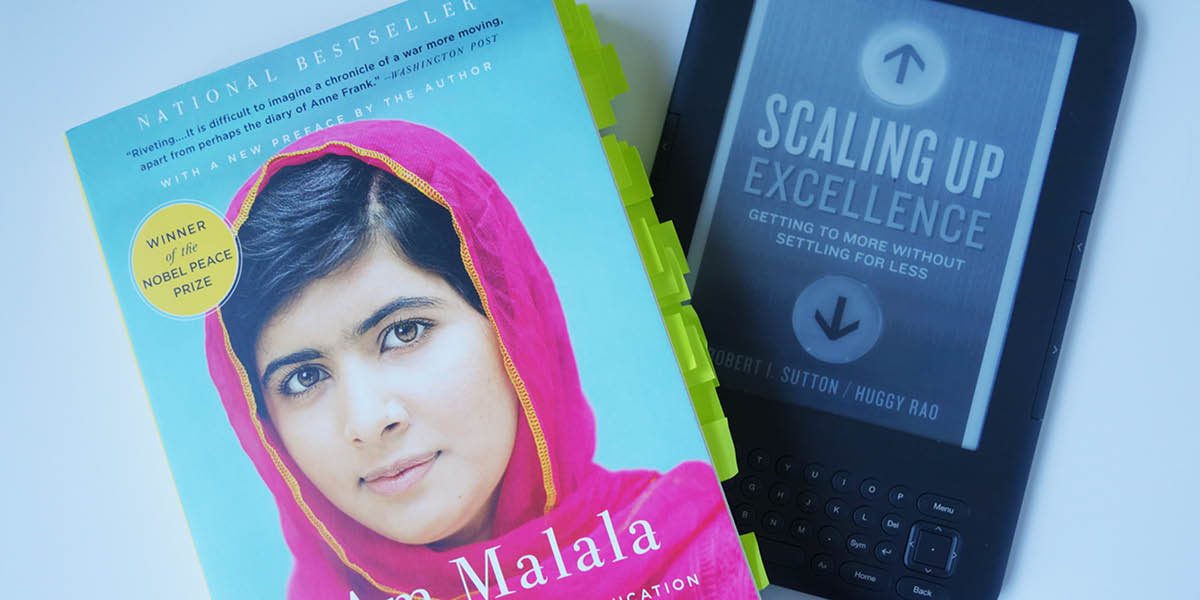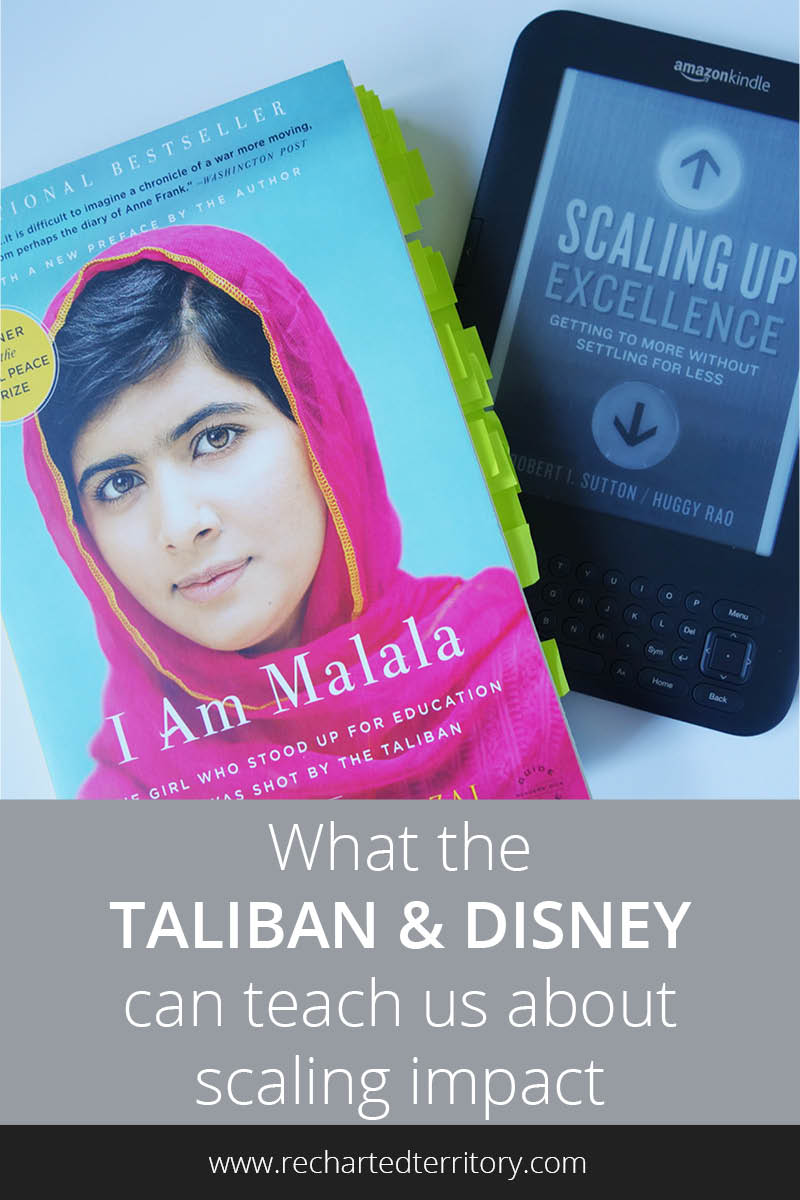

This week I thought I’d share my reflections on two books I read during September, as well as ways to channel inspiration from these books into your projects and daily life.
The books were “I am Malala: The Girl Who Stood Up for Education and Was Shot by the Taliban” by Malala Yousafzai and Christina Lamb and “Scaling Up Excellence: Getting to More Without Settling for Less” by Robert I. Sutton and Huggy Rao.
They were stuffed with stories, anecdotes, advice and inspiring moments so if you haven’t already, I definitely encourage you to check them out. One general theme that emerged was the idea of standing your ground and making an impact when the systems seem to be against you. The following three tips, inspired by these two books, are ways to kick off the scaling process when it seems impossible.
1. Clarify your values to maintain your spark when the system is trying to snuff it out
While reading Malala’s account of her experience as the Taliban took over the Swat Valley I was struck by the clarity that she had in her values and mission. In the midst of the chaos and fear she knew her mission was to learn and to help other girls receive the education they deserved. Like anyone, she and her father had moments of doubt and fear but they could turn to their core mission to guide them. Starting small didn’t stop them and as Malala shares her message more, her confidence and conviction grows.
If one man, Fazlullah, can destroy everything, why can’t one girl change it?
– Malala Yousafzai
Application to daily life
Malala’s core mission and values were reflected countless times during the book which seemed to contribute to her inner strength. To hone your own personal brand and mission, try keeping a career journal. Keep this separate from your normal work or project notes, because it should be about defining and growing your personal brand and values. Track your goals, mission, plans, and action items and reflect on the highs and lows as you encounter setbacks and wins.
2. Don’t be afraid to speak up and inspire others
All of the changemakers in both books held a strong belief that they could make a difference with the right tools and techniques. Malala and her father made an impact via writing and speeches, while Facebook uses a “Bootcamp” program to share their mindset with new recruits and scale their culture.
Probably one of my favorite quotes in Malala’s book was when her father’s friend, Hidayatullah is encouraging him to stand up against the Taliban,
“Life isn’t just about taking in oxygen and giving out carbon dioxide. You can stay there accepting everything from the Taliban or you can make a stand against them.”
– Hidayatullah, quoted by Malala Yousafzai
and the public response after her father speaks up,
“You have put the first stone in standing water,” they said. “Now we will have the courage to speak.”
– Community member, quoted by Malala Yousafzai
Application to daily life
Malala and the successful scaling teams in the anecdotes provided by Sutton and Rao were able to balance the “poetry and plumbing” of inspiring people to act and showing them the first steps. Take inspiration from Malala and create a presentation, memo or pitch describing your viewpoint. Share it with a friend, colleague, team, or your organization. Then shift into “plumbing” mode a la Sutton and Rao and identify a small change and act upon it right away to gain momentum.
3. Design your environment
Before reading these books, I assumed that the majority of the tactics in change initiatives would be based on visionary speeches, self-organizing teams, and shifting mindsets. Sutton and Rao highlight the influence that little details in our environments can play to make or break scaling efforts.
They recommend that scaling teams try to “engage all of the senses” during their efforts, citing research from psychologists about the power of music, scents, temperature, and objects to influence our behaviors and choices subconsciously. The good news is that we can tweak those subtle details to improve customer and team experiences, but the bad news is that any negative details or “broken windows” are extra powerful.
Disney recognized this and makes it their mission to reduce any “dissonant details” in their parks. In chapters 1 and 7, Sutton and Rao talk about multiple experiments and case studies in this area, including the case of Disney, where all “cast members” are instructed to focus on alleviating poor customer experiences as quickly as possible.
Disney cast members act as if eliminating the negative is at least as important as amplifying the positive.
– Robert I. Sutton and Huggy Rao
On the other end of the spectrum there is the environment in Pakistan. After all of the events in Swat, the Taliban and military occupation, there is then a flood and Malala writes that “people were desperately worried that the Taliban would take advantage of the chaos and return to the valley.” The longer stores and schools are closed, the more trash that piles up, the more political figures assassinated, and timeless statues destroyed, through Malala’s eyes the public’s hopelessness grows. Her beautiful and peaceful valley had shifted to a place where joining or supporting the Taliban was the easiest way to avoid fear and to obtain money and status.
Application to daily life
Find something relatively small but visible that causes a negative experience for your team. Fix it, even if it’s outside of your normal job activities. Perfect candidates are anything that are a pain point for the group but that do not have a clear owner, which could be something related to knowledge management, communication, training, process definition, or your office environment.
There were so many lessons in both of these books that it would take months of posts to explore all of these topics in depth. What were your favorite takeaways from these books? How would you encourage people to apply those principles in their own projects?
By the way, the reading for October is “An Astronaut’s Guide to Life on Earth: What Going to Space Taught Me About Ingenuity, Determination, and Being Prepared for Anything” by Col. Chris Hadfield. If you’ve already read the book, check out the review and discussion here: Career advice from an astronaut